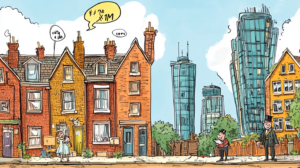April 2025 marks a pivotal moment in the UK property market as the temporary stamp duty relief, introduced to buoy a struggling housing market, is set to expire. The changes will see the nil-rate band drop from its current £250,000 level back to £125,000, meaning that anyone buying a property above £125,000 will now start paying stamp duty. For first-time buyers, the shift is even more dramatic. Presently, they benefit from a generous relief that exempts purchases up to £425,000 and applies a 5% rate between £425,001 and £625,000. Come April 2025, however, first-time buyers will only enjoy a tax-free band up to £300,000, with the relief ending completely above a purchase price of £500,000. In effect, many more buyers, particularly in high-cost regions like London, will face a higher upfront tax bill.
The rationale behind these changes is multifaceted. The stamp duty cut was initially introduced in late 2022 as a temporary measure to stimulate a housing market that was showing signs of weakness. By boosting buyer activity, the government hoped to support a sector that is vital not only for personal wealth but also for the wider economy. However, as the market shows signs of stabilizing and with house prices already reaching record highs, the government has signalled its intention to revert to more traditional thresholds. This move is also driven by fiscal considerations: restoring the lower threshold is expected to generate over £1.1 billion in additional tax revenue annually, a critical boost for the public coffers in challenging economic times.

For first-time buyers, the upcoming changes are a double-edged sword. On one hand, they may feel the sting of a tax increase that could significantly raise the cost of entering the property ladder. In London, where average first-time buyer properties hover around £450,000, nearly 80% of buyers will now have to pay stamp duty, compared to roughly half under the current system. This added cost is likely to prompt many young buyers to accelerate their purchase plans to beat the April deadline. For those unable to do so, the increased tax could delay their entry into the market, potentially impacting overall demand.
Homeowners looking to move or upgrade will also feel the pinch. Previously, many home movers benefitted from a relatively generous tax-free allowance on properties priced between £125,000 and £250,000. With this band now taxable at 2%, a typical mover could expect to pay an additional £2,500 in stamp duty—a cost that might discourage some from making a move. Meanwhile, buy-to-let investors and second-home buyers are set to face an even stiffer tax burden. These buyers already contend with a surcharge—3% under current rules, and potentially 5% following recent government measures—so that with the revised nil-rate band, their overall tax liabilities will only increase further. This policy is intended to help rebalance the market by curbing speculative investments and freeing up homes for owner-occupiers.
The stamp duty changes come amid a broader context of housing policy reform and economic uncertainty. Over recent years, the government has been gradually shifting its approach from short-term stimulus measures toward long-term structural reforms. The temporary nature of the current stamp duty relief was always intended to be a stopgap measure during a period of economic turbulence. With house prices recovering and the market stabilizing, returning to a higher tax base is seen as a necessary step for both fiscal responsibility and market normalisation.
To fully understand today’s changes, it is useful to look back at the history of stamp duty in the UK. Originating in 1694 to fund wars against France, stamp duty has evolved considerably over the centuries. Initially a fixed fee on legal documents, it eventually became an ad valorem tax linked to property values. Major reforms over the past few decades—such as the introduction of Stamp Duty Land Tax (SDLT) in 2003 and the progressive, slice-based system adopted in 2014—have shaped the current structure. These reforms aimed to make the tax fairer and more responsive to market conditions, though they have also contributed to a complex system with multiple bands and targeted reliefs. The evolution of stamp duty in the UK stands in contrast to property taxes elsewhere; for example, while the United States relies on relatively low, recurring property taxes, many European countries use a flat transaction tax, and Asian markets like Hong Kong and Singapore impose even more onerous surcharges on secondary properties.
Political and market reactions to the upcoming changes have been mixed. Proponents argue that reverting to traditional thresholds is necessary to prevent the property market from overheating and to ensure a steady flow of revenue for government initiatives. Critics, on the other hand, contend that the changes could disproportionately hurt first-time buyers and slow down market mobility, particularly in high-demand areas such as London. As the deadline approaches, there is a palpable rush among buyers and sellers to complete transactions under the old regime, leading to a temporary surge in market activity. Once the new rules take effect, however, many expect a brief cooling period as the market adjusts to the higher costs.
As the market continues to evolve, the story of stamp duty remains one of adaptation and balance, a historical thread that continues to influence the dream of homeownership in modern Britain.



